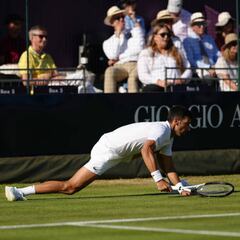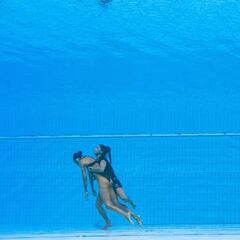Andrea Fuentes: “Sports means going to your limit and sometimes beyond it”
Andrea Fuentes speaks with AS from the American hotel in Budapest after rescuing swimmer Anita Álvarez when she fainted underwater.

First things first. Andrea Fuentes arrived at The Aquincum hotel, in Buda, just a the foot of the Arpa bridge that crosses the Danube, only a mile from the event, worried about her soloist Anita Álvarez, who had fainted while underwater and spent two minutes without breathing in the Margaret Island swimming pool in Budapest. Anita, who was brought back to the hotel by car, is smiling and convinced that it was just a momentary scare and that she will be able to compete this Friday in the free solo finals with her team mates. “She wants to and she is able, but we have to make a decision about it,” explains Fuentes.
Once Álvarez is resting in her room, not yet 9 p.m., Fuentes, now able to calm down a bit, explains the events that took place just four hours earlier, when the synchronized swimming team along with all of the spectators were left with their hearts in their mouths for a few minutes. Andrea, who has won four Olympic medals herself, speaks of a moment that will be difficult for this fierce competitor to forget.
Two-time Olympics swimmer Anita Alvarez fainted and sank to the bottom of the pool during the World Aquatics Championships.
— The Washington Post (@washingtonpost) June 23, 2022
Her coach on Team USA, Andrea Fuentes, dived in to save her, scooping her limp body up and rushing her back to the water’s surface. https://t.co/HA221Uhvf4 pic.twitter.com/nryPGpwKY2
Has something like this happened before?
It’s not that unusual, sometimes it happens when we train. People who are involved in diving, just like scuba divers, don’t see it as strange, because it sometimes happens. There are moments when the body just collapses, and you stop breathing. I remember during the Peking games in 2008, it happened to one of the Japanese team and they also had to be pulled from the water. The unusual thing is that it happened in during competition.
Is this the first time that it has happened to Anita?
She is a competitor who pushes herself to the limit, and sometimes beyond it. It isn’t the first time, but what happened previously was that she floated and was able to keep breathing. It happened to me in the pre-Olympics. This time was very different. A few team mates, once everything was over, told me that it has happened to them as well during practice.
As the American artistic swimmer Anita Alvarez fainted and sank toward the bottom of the pool at the world championships, her coach Andrea Fuentes made a split-second decision: She dove in to save her.
— The New York Times (@nytimes) June 23, 2022
Alvarez is doing "fine" now, her coach said. https://t.co/w5b9w4t1Iz pic.twitter.com/msOBUa3PY7
Tell us what was going through your mind when it happened.
When I saw her sink, I looked at the lifeguards, but I saw that they were dumbfounded. They didn’t react at all. I thought, “Are you going to jump in?” My reflexes kick in quickly, that’s how I am, I can’t just stand there looking. So I didn’t even think about it, I jumped in. I think that was the craziest and quickest I have ever dove in my career. I grabbed her and surfaced, obviously she was heavy, just dead weight, and it wasn’t easy.
What happened next?
A lifeguard arrived but, to be honest, he didn’t help me out very much. I have taken courses on this and knew that we needed to put her in a position on her side, where she wouldn’t swallow any water so that she could start breathing. He wanted to put her on her back, and we had an absurd little fight about what position she should be in. It didn’t help that he couldn’t understand me because he doesn’t speak any English. In the end, we managed to get her out of the water.
American synchronized swimmer Anita Alvarez faints and sinks to bottom of the pool during World Championships. Her coach, Andrea Fuentes, heroically dives in and saves her. Alvarez is recovering well. pic.twitter.com/ne369qFUhg
— Mike Sington (@MikeSington) June 23, 2022
What went on once she was out of the spectators view?
After two minutes, she reacted, started breathing, spit up a bunch of water… She was confused as you would expect. They wanted to put an apparatus on her to help her breathe better, but she was overwhelmed and didn’t want it. They kept talking to her, trying to calm her down, telling her that it was all ok, and she eventually started to calm down. And from there, the danger passed.
Does synchronized swimming present more risk than the public is aware of?
Every elite sport carries risk. In athletics and cycling the athletes vomit and pass out as well. Our problem is that because our sport takes place in the water, those things can become much more serious, and on top of that, the fact that it happened that in this event, she was alone. Sports means going to your limits and sometimes you go beyond them.
American artistic swimmer, Anita Alvarez, was saved from drowning by her coach, Andrea Fuentes, at the World Championships after losing consciousness.
— Sky Sports News (@SkySportsNews) June 23, 2022
You have been with Team USA for many years. How do you see things going for them?
Related stories
I am learning so much from this experience: we are a country that has such a high level of sports where everything works. I am learning to run a team, a bit of psychology, learning through a test of fire, grinding it out, but quickly. I like challenges. This US team was like Spain before they won, completely buried. My mission is the same as Anna Tarrés’ mission, but in my own way. The US was the best when I was a little girl and they were my inspiration to get into synchronized swimming. I am so thankful that they believed in me, in my mission to bring them back to the top. Sometimes it is difficult, the system is very precarious, we don’t have a pool and it is difficult for the coaches. The parents put a lot of pressure on you. There are no subsidies, everything is private, there are no government-funded sports academies. Now I really value what Spain has.
U.S. coach Andrea Fuentes prevented a tragedy at the aquatics world championships with her quick reaction https://t.co/8GarfJz4cI
— CBC Olympics (@CBCOlympics) June 23, 2022
(Andrea Fuentes is tied with Mireia Belmonte and Arantxa Sánchez Vicario as the Spanish athletes with the most Olympic medals. She won two silver medals in the Peking Olympics and a silver and bronze medal in the London Olympics. As well, she has won a ton of European and World medals. She retired in 2013 and is a lifelong synchronized swimming innovator. Her quick reaction helped to alleviate a serious situation with solo swimmer Anita Álvarez, better than any medal.)


